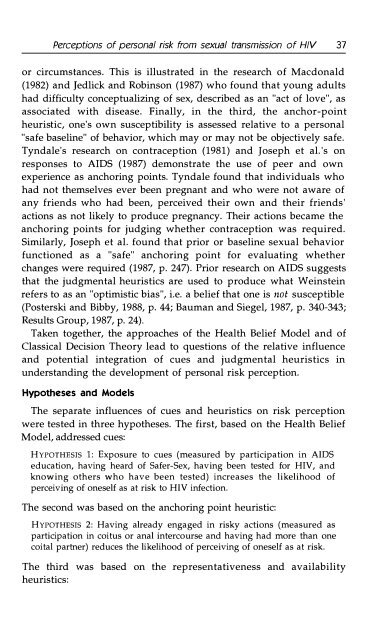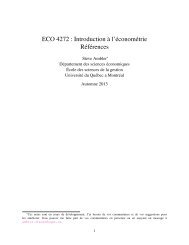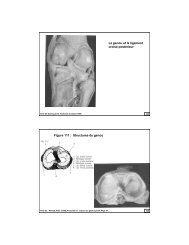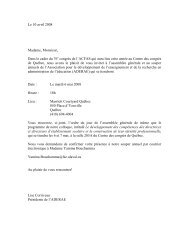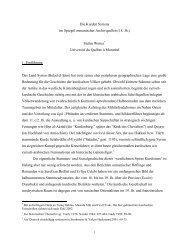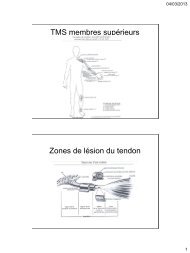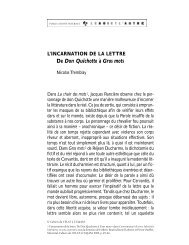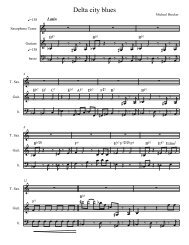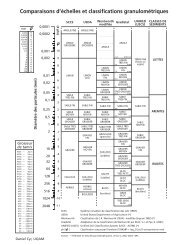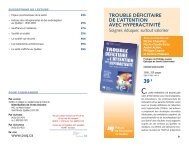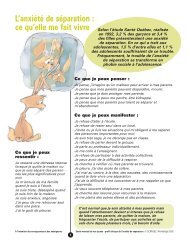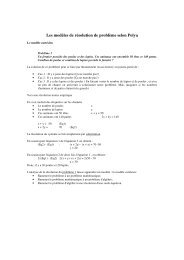Télécharger la revue en format "pdf". - UQAM
Télécharger la revue en format "pdf". - UQAM
Télécharger la revue en format "pdf". - UQAM
You also want an ePaper? Increase the reach of your titles
YUMPU automatically turns print PDFs into web optimized ePapers that Google loves.
Perceptions of personal risk from sexual transmission of HIV 37<br />
or circumstances. This is illustràted in the research of Macdonald<br />
(1982) and Jedlick and Robinson (1987) who found that young adults<br />
had difficulty conceptualizing of se x, described as an "act of love", as<br />
associated with disease. Finally, in the third, the anchor-point<br />
heu ris tic, one's own susceptibility is assessed re<strong>la</strong>tive to a personal<br />
"safe baseline" of behavior, which may or may not be objectively safe.<br />
Tyndale' s research on contraception (1981) and Joseph et al.' s on<br />
responses to AlOS (1987) demonstrate the use of peer and own<br />
experi<strong>en</strong>ce as anchoring points. Tyndale found that individu aIs who<br />
had not themselves ever be<strong>en</strong> pregnant and who were not aware of<br />
any fri<strong>en</strong>ds who had be<strong>en</strong>, perceived their own and their fri<strong>en</strong>ds'<br />
actions as not likely to produce pregnancy. Their actions became the<br />
anchoring points for judging whether contraception was required.<br />
Simi<strong>la</strong>rly, Joseph et al. found that prior or baseline sexual behavior<br />
functioned as a "safe" anchoring point for evaluating whether<br />
changes were required (1987, p. 247). Prior research on AlOS suggests<br />
that the judgm<strong>en</strong>tal heuristics are used to produce what Weinstein<br />
refers to as an "optimistic bias", i.e. a belief that one is not susceptible<br />
(Posterski and Bibby, 1988, p. 44; Bauman and Siegel, 1987, p. 340-343;<br />
Results Group, 1987, p. 24).<br />
Tak<strong>en</strong> together, the approaches of the Health Belief Model and of<br />
C<strong>la</strong>ssical Decision Theory lead to questions of the re<strong>la</strong>tive influ<strong>en</strong>ce<br />
and pot<strong>en</strong>tial integration of cues and judgm<strong>en</strong>tal heuristics in<br />
understanding the developm<strong>en</strong>t of personal risk perception.<br />
Hypotheses and Models<br />
The separate influ<strong>en</strong>ces of cues and heuristics on risk perception<br />
were tested in three hypotheses. The first, based on the Health Belief<br />
Model, addressed cues:<br />
HYPOTHESIS 1: Exposure to cues (measured by participation in AIDS<br />
education, having heard of Safer-Sex, having be<strong>en</strong> tested for HIV, and<br />
knowing others who have be<strong>en</strong> tested) increases the likelihood of<br />
perceiving of oneself as at risk to HIV infection.<br />
The second was based on the anchoring point heuristic:<br />
HYPOTHESIS 2: Having already <strong>en</strong>gaged in risky actions (measured as<br />
participation in coitus or anal intercourse and having had more than one<br />
coital partner) reduces the likelihood of perceiving of oneself as at risk.<br />
The third was based on the repres<strong>en</strong>tativ<strong>en</strong>ess and avai<strong>la</strong>bility<br />
heuristics:


